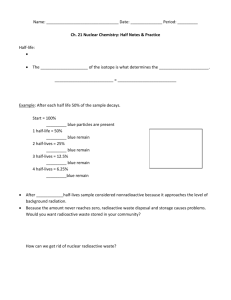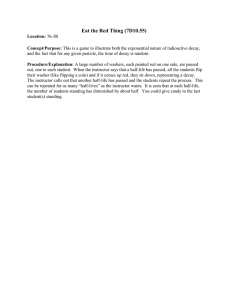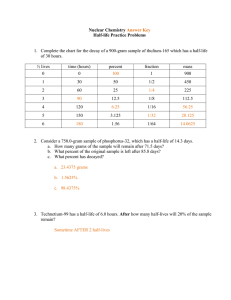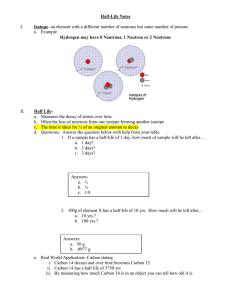Nuclear Chemistry Section 4.4, Chapter 24
advertisement
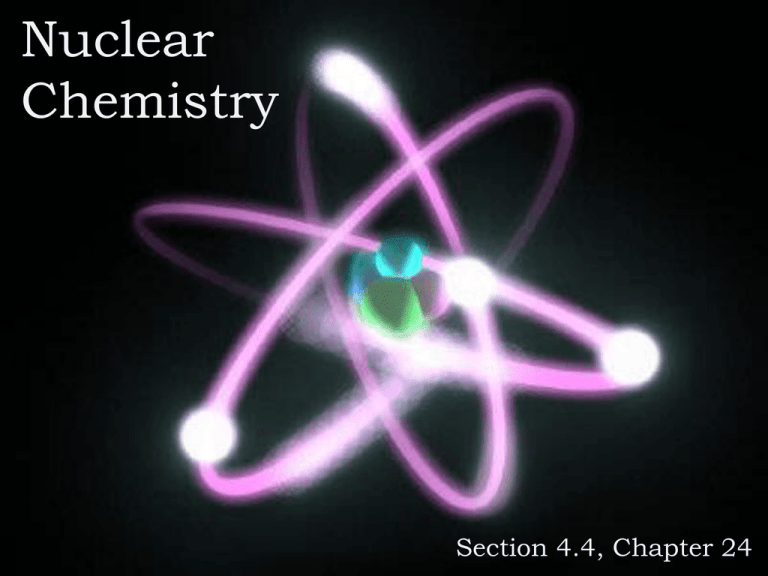
Nuclear Chemistry Section 4.4, Chapter 24 Nuclear Chemistry Chemical Rxns • Chemical bonds are broken and formed • Atoms are unchanged, only rearranged • Involve valence electrons • Small energy changes • Rxn rate affected by temperature, pressure, concentration, and catalysts Nuclear Rxns • Nuclei emit particles and/or rays • Atoms converted to new elements • May involve p+, n0, and e– • Large energy changes • Rate not affected by temperature, pressure, or catalysts What is Radiation? • Radiation or radioactive decay – substances spontaneously emit radioactive rays and particles – Radioactive isotopes (atomic number > 83) have unstable nuclei – Neutron to proton ratio is not 1:1 (too many neutrons) • Unstable nucleus decays to become more stable – Releases tremendous amount of energy – Atom forms a new element Radioactivity Decay Type Emission Composition Alpha decay Alpha particles Two p+ and two n0 (helium nucleus) Beta decay Beta particles Fast-moving electron Gamma emission* Gamma rays High energy photons *Accompanies alpha and beta decay Symbol Charge Mass Penetrating Power 4 2+ 4 amu Paper ß 1– 0 amu Metal foil γ 0 0 amu Lead, concrete He 2 0 –1 0 0 Balancing Nuclear Equations • Nuclear equations express nuclear reactions – Use isotopic notation – Show that atomic numbers and mass numbers are conserved • Process 1. Balance the number of nucleons (protons and neutrons) using mass number 2. Balance the charge using atomic number 3. Determine the decay product (alpha or beta particles) and write balanced equation Nuclear Reactions • Transmutation: nuclear reaction; reaction in which atomic number (number of protons) is changed – Radioactive decay (alpha and beta) • Induced transmutation: striking nuclei with high-velocity particles to cause nuclear reaction • Elements with atomic number > 92 are considered transuranium elements – Synthetic elements – Created by induced transmutation Fission Fusion Fission • Large, unstable nucleus is bombarded by a neutron • Heavy nucleus splits into two smaller, more stable nuclei • New isotopes are formed while emitting a neutron Fission • Process continues forming chain reaction • Explosion from atomic bomb results from uncontrolled chain reaction Fission in Nuclear Power Plants Fusion • Two small nuclei combine to form larger, more stable nucleus is nuclear fusion • Releases more energy than nuclear fission but requires extremely high temperatures • Sun and stars are powered by fusion reactions Fusion • All elements heavier than helium are formed through nuclear fusion Half-Life • Radiochemical dating: process of determining the age of an object by measuring the amount of a certain radioisotope that remains • Decay rates of radioactive nuclei are constant and are referred to as the half-life of the radioisotope Carbon-14 is used for specimens less than 20,000 years old and were once living. Potassium-40 has been used to date ancient rocks and minerals. Half-Life 0 1 2 3 4 5 6 7 Number of Half-Lives The half-life of strontium-90 is 29 years. If you had 100. grams today, how much Sr-90 would remain in 116 years? How many half-lives will have passed in 116 years? 4 half-lives 29 years → 58 years → 87 years → 116 years Formulas for Half-Life Amount remaining = (Initial amount)(1/2) n where n = number of half-lives passed Amt = (100. g)(1/2)4 Amt = 6.25 g Amount remaining = (Initial amount)(1/2) t/T where t = elapsed time and T = duration of half-life Amt = (100. g)(1/2)116 yrs/29 yrs Amt = 6.25 g Calculating Half-Life The half-life of strontium-90 is 29 years. If you had 100. grams today, how much Sr-90 would remain in 116 years? # HL Time Amount 0 0 100. g Calculating Half-Life The half-life of strontium-90 is 29 years. If you had 100. grams today, how much Sr-90 would remain in 116 years? # HL Time Amount 0 0 100. g 1 29 yrs 50.0 g Calculating Half-Life The half-life of strontium-90 is 29 years. If you had 100. grams today, how much Sr-90 would remain in 116 years? # HL Time Amount 0 0 100. g 1 29 yrs 50.0 g 2 58 yrs 25.0 g Calculating Half-Life The half-life of strontium-90 is 29 years. If you had 100. grams today, how much Sr-90 would remain in 116 years? # HL Time Amount 0 0 100. g 1 29 yrs 50.0 g 2 58 yrs 25.0 g 3 87 yrs 12.5 g Calculating Half-Life The half-life of strontium-90 is 29 years. If you had 100. grams today, how much Sr-90 would remain in 116 years? # HL Time Amount 0 0 100. g 1 29 yrs 50.0 g 2 58 yrs 25.0 g 3 87 yrs 12.5 g 4 116 yrs 6.25 g Add to U3-1 Classwork/Homework The half-life of tritium or H-3 is 12 years. If you start with 200. grams of tritium, how many half-lives will have passed when only 25.0 grams remain? How much time will have passed? # HL Time Amount 0 0 200. g Add to U3-1 Classwork/Homework The half-life of tritium or H-3 is 12 years. If you start with 200. grams of tritium, how many half-lives will have passed when only 25.0 grams remains? How much time will have passed? # HL Time Amount 0 0 200. g 1 12 yrs 100. g Add to U3-1 Classwork/Homework The half-life of tritium or H-3 is 12 years. If you start with 200. grams of tritium, how many half-lives will have passed when only 25.0 grams remains? How much time will have passed? # HL Time Amount 0 0 200. g 1 12 yrs 100. g 2 24 yrs 50.0 g Add to U3-1 Classwork/Homework The half-life of tritium or H-3 is 12 years. If you start with 200. grams of tritium, how many half-lives will have passed when only 25.0 grams remains? How much time will have passed? # HL Time Amount 0 0 200. g 1 12 yrs 100. g 2 24 yrs 50.0 g 3 36 yrs 25.0 g 3 half-lives; 36 years

